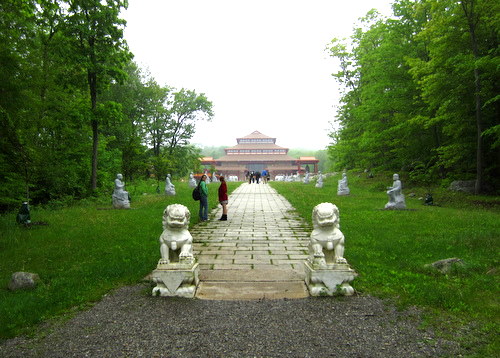The Chuang Yen Monastery in Kent, New York doesn’t really belong in this blog’s “Japanese Culture” category since it was built by Chinese immigrants. However there is a huge amount of overlap between Chinese and Japanese Buddhism, so I’m going to treat it as “close enough.”
The Bodhi Path at the entrance is lined with statues of Gautama Buddha’s original male disciples.

I don’t know why the female disciples were left out. Somehow they often get shortchanged.

The Great Buddha Hall was designed with the help of the famous architect I.M. Pei, based on the architectural styles of the Tang Dynasty (CE 618-907).

Inside is the largest indoor Buddha image in North America, a representation of the Vairocana Buddha over 40 feet tall. It sits on a lotus flower on top of a round pedestal carved with images of bodhisattvas. The pedestals is surrounded by a curved wall on top of which sit 10,000 little buddhas, symbolizing that all the buddhas in all the worlds reflect the Vairocana.

On the outside of the curved wall is a mural showing scenes from the life of Bodhidharma.

The mural on the inner wall depicts scenes from the Pure Land.

Amitabha (Amida) Buddha sits surrounded by bodhisattvas.

A wishing pool featuring an image of the Bodhisattva Kuan Yin (Kannon).

A jolly Hotei greets visitors at the main entrance.

A traditional painting of the birth of Gautama Buddha.

A shrine used for funeral services is presided over by the Bodhisattva Ksitigarbha (Jizou).

Next to the Great Buddha Hall is the Kuan Yin Hall, a smaller building in the same architectural style. The main floor features a large auditorium/meditation hall. The lower level has living quarters for nuns and female visitors.


Inside is a priceless 700-year-old porcelain statue of Kuan Yin, which is supposed to be the largest 5-colored porcelain image on Kuan Yin in the world.

The cemetery has two Thousand Lotus Memorial Terraces, each filled with niches for the ashes of deceased parishioners.

A kiln for burning fake paper money, a traditional Chinese offering for the dead.

The Seven Jewels Lake (more of an artificial pond, but quite attractive.)

The lake has yet another large statue of Kuan Yin.

Monks converse at the back of the lecture hall at the Woo Ju Memorial Library.


